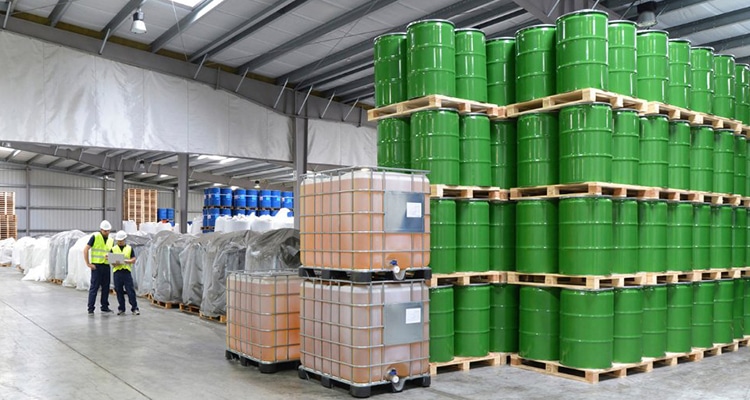ERP/MRP software suites often treat chemicals and hazardous material as just another inventory class without considering the financial and environmental consequences. Furthermore, Environmental, Social, and Governance (ESG) has taken center stage among institutional investors, corporate boards, C-suite executives, and business media.
Operating costs to manage chemical inventories can range from $1 to $10 per purchasing dollar spent depending on supply chain and operational efficiency. Simultaneously, environmental regulatory compliance is increasingly complex, customer compliance more demanding, and forgiveness for noncompliance is rare.
Many industrial, warehousing, and transportation companies have inherited and maintained a patchwork of legacy software, SaaS solutions, and spreadsheets to track inventories for chemical inventory management and regulatory compliance. Older or fragmented inventory systems are just one error away from a workplace chemical incident, retroactive financial penalties, full-blown audits, and years of future regulatory monitoring.
Companies can no longer gamble with the improbability they won’t be inspected or audited by regulatory agencies as remote auditing techniques are either implemented or being developed.
Alternatively, a fully integrated chemical inventory SaaS solution using mobile barcode technology can reduce regulatory compliance risk for around $1,000 per user per year.
Chemical Inventory Center of Excellence
It’s not just financial and regulatory risk reductions resulting from sound chemical inventory management. Chemical products are experiencing the same supply chain woes as every other industry putting order delivery, customer compliance, and preferred vendor status at risk. Carrying excessive safety stock increases costs, decreases cash, raises the risk of storing and using expired chemicals, and increases hazardous waste disposal costs.
Hazard Communication ranked 4th in 2021 in the OSHA’s “Top 10 Most Frequently Cited Standards” and international compliance has become a focal point as the Globally Harmonized System of Classification and Labelling of Chemicals (GHS) is rolled out worldwide.
Many organizations, including the EPA, have leveraged Chemical Safety’s flexible, scalable Environmental Management Systems (EMS) software into Centers of Excellence to manage increasing supply chain, environmental, and regulatory risk.
EMS software tracks chemical inventory movement throughout an organization using barcode technology for accurate, real-time inventory levels. Mobile barcode technology is the most efficient tool to manage chemical inventory quickly and accurately eliminating data entry errors, minimizing waste, and automating environmental compliance and reporting.
Centralizing chemical management is only effective through administrative process automation. EMS software automates:
- Procurement – The EMS purchase order function interfaces with an organization’s ERP/MRP platform. Companies can define approval processes, establish points-of-contact, automate reorder points, manage vendors, and set stop limits to prevent chemical overstock. Attached to each inventory item is an SDS, GHS label, and barcode to comply with workplace health and safety.
- Receiving & Warehousing – The receiver calls up the P.O. in EMS upon delivery. The barcode is attached to the pallet or container and scanned automatically adding items to inventory. Storage compatibility rules are defined by chemical or hazard class with check-out, check-in capability for chemical stores.
- Production Tracking – It’s not just inventory quantities that are needed for regulatory compliance but locations where they are stored, maximum container size, and maximum amount stored at any time within the facility. Production workers scan the barcode as items move through the manufacturing process and automatically update storage locations. This provides traceability for customer QA compliance.
- Shipping – Bills of Lading and manifests can be printed in EMS and/or transmitted to transporters and disposers (TSDFs). Product barcodes are printed and affixed to the shipment. Labels, pictograms, and hazard communications that are GHS and DOT compliant and available in a multitude of sizes and languages.
- Hazardous Waste Disposal – all aspects of generating, storing, shipping, incinerating, recycling, or landfilling hazardous waste comply with regulatory agencies.
- Regulatory Reporting – Federal, state, and local regulatory reports are formatted for e-filing or printable for paper filing as needed. Automatic cloud-based reporting updates are seamlessly added to EMS. Regulatory threshold notifications are sent automatically.
- Workplace Health & Safety – EMS improves Hazard Communication. OSHA compliance includes digital SDS, GHS labels, hazard classifications, and chemical compatibility storage rules easily accessed by mobile phone. EMS records and e-files workplace chemical incidents and accidents.
Economic uncertainty isn’t typically the best time to pitch an integrated Environmental Management System, but this time may be different. Our current economic and regulatory landscape may have created the perfect storm for production managers to justify EMS software. Not just to solve the regulatory puzzle but to re-engineer administrative processes for efficiency gains and customer compliance.
Chemical Safety’s Environmental Management Systems (EMS) has been the industry’s most mature and comprehensive software solution. With more than 30 years of experience, thousands of deployments, and tens of thousands of active users, Chemical Safety has a solid history of successful implementations and satisfied customers with many of the largest and emerging corporate, industrial, and government entities in the US and beyond. If you want to learn more about Chemical Safety’s offerings, contact us at sales@chemicalsafety.com



